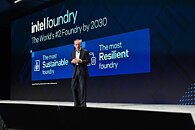- Joined
- Aug 19, 2017
- Messages
- 2,929 (1.05/day)
Last time we reported on Samsung Foundry, the company publicly apologized for its setbacks in the memory and foundry divisions, especially as its 3 nm GAA FET node has failed to attract new customers. On the other hand, Intel has also been struggling with its Foundry unit bleeding billions of Dollars in a bid to secure its spot as one of the best foundries for companies to manufacture their chips. There is no better pair than two struggling foundries looking for customers and new ways to conduct research than Intel and Samsung. According to an exclusive by South Korean media outlet "MK," it has reportedly been confirmed that Intel approached Samsung to form a "Foundry Alliance" to boost their foundry business units.
According to the source, Intel CEO Pat Gelsinger is reportedly eager to meet with Samsung Electronics Chairman Lee Jae-yong face-to-face to discuss "comprehensive collaboration in the foundry sector." What exactly will happen between the two is still unclear. Back in 2014, GlobalFoundries and Samsung formed a partnership for 14 nm FinFET offerings, and that was a wide success. Jointly developing a node and offering it in their foundry units could be the target goal for Intel and Samsung. At some level, research and development, as well as sharing valuable manufacturing information on yield improvements, should be beneficial for both to put together the final pieces of the semiconductor puzzle.

View at TechPowerUp Main Site | Source
According to the source, Intel CEO Pat Gelsinger is reportedly eager to meet with Samsung Electronics Chairman Lee Jae-yong face-to-face to discuss "comprehensive collaboration in the foundry sector." What exactly will happen between the two is still unclear. Back in 2014, GlobalFoundries and Samsung formed a partnership for 14 nm FinFET offerings, and that was a wide success. Jointly developing a node and offering it in their foundry units could be the target goal for Intel and Samsung. At some level, research and development, as well as sharing valuable manufacturing information on yield improvements, should be beneficial for both to put together the final pieces of the semiconductor puzzle.

View at TechPowerUp Main Site | Source






